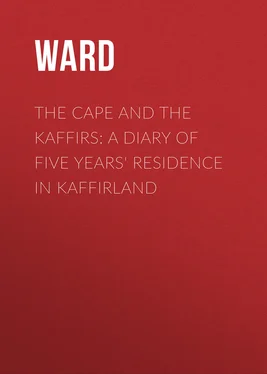Ward - The Cape and the Kaffirs - A Diary of Five Years' Residence in Kaffirland
Здесь есть возможность читать онлайн «Ward - The Cape and the Kaffirs - A Diary of Five Years' Residence in Kaffirland» — ознакомительный отрывок электронной книги совершенно бесплатно, а после прочтения отрывка купить полную версию. В некоторых случаях можно слушать аудио, скачать через торрент в формате fb2 и присутствует краткое содержание. Издательство: Иностранный паблик, Жанр: foreign_prose, История, foreign_edu, foreign_antique, на английском языке. Описание произведения, (предисловие) а так же отзывы посетителей доступны на портале библиотеки ЛибКат.
- Название:The Cape and the Kaffirs: A Diary of Five Years' Residence in Kaffirland
- Автор:
- Издательство:Иностранный паблик
- Жанр:
- Год:неизвестен
- ISBN:нет данных
- Рейтинг книги:4 / 5. Голосов: 1
-
Избранное:Добавить в избранное
- Отзывы:
-
Ваша оценка:
- 80
- 1
- 2
- 3
- 4
- 5
The Cape and the Kaffirs: A Diary of Five Years' Residence in Kaffirland: краткое содержание, описание и аннотация
Предлагаем к чтению аннотацию, описание, краткое содержание или предисловие (зависит от того, что написал сам автор книги «The Cape and the Kaffirs: A Diary of Five Years' Residence in Kaffirland»). Если вы не нашли необходимую информацию о книге — напишите в комментариях, мы постараемся отыскать её.
The Cape and the Kaffirs: A Diary of Five Years' Residence in Kaffirland — читать онлайн ознакомительный отрывок
Ниже представлен текст книги, разбитый по страницам. Система сохранения места последней прочитанной страницы, позволяет с удобством читать онлайн бесплатно книгу «The Cape and the Kaffirs: A Diary of Five Years' Residence in Kaffirland», без необходимости каждый раз заново искать на чём Вы остановились. Поставьте закладку, и сможете в любой момент перейти на страницу, на которой закончили чтение.
Интервал:
Закладка:
The discontented Dutch, who had been gradually irritated by these proceedings, now began to migrate with their families over various branches of the Orange River, to the north-east of the colony. They were forbidden to take their apprentices with them; but in many instances they disregarded this order, and parties of military being sent after them, to bring the apprentices back to the colony, this measure increased the feelings of resentment already excited in the minds of the Dutch towards the English, and the commanders of such military parties ran imminent risks of their lives in the execution of these duties. Having established themselves in various localities beyond the north-eastern boundary, and having no legal executive among themselves, the Boers occasionally returned to the colony when any appeal to justice was required; but, by degrees, the stream of emigration having set steadily outwards, it swelled to such an extent that it called for more room in its progress, and, spreading itself beyond the limits of British jurisdiction or restraint, at length reached Natal. The most determined emigrants came to a resolution to establish for themselves, in the neighbourhood of that port, a colony totally independent of British rule, and regulated by their own laws. Meanwhile the Kaffir war had been, by the energy and decision of Sir Benjamin D’Urban and Colonel Smith (now Sir Harry Smith, the hero of Aliwal, and the Governor of the Cape), brought to an end. The aggressors were driven from the colony, and also from a neighbouring district between the Keiskama and the Kei, which was erected into a province called Adelaide, and stringent measures taken to prevent their again bursting into the colony. But these measures were disapproved of by Lord Glenelg, then the Colonial Secretary, the new district was abandoned, Sir Benjamin D’Urban resigned, and, under the auspices of Sir Andries Stockenstrom, the Lieutenant-Governor of the eastern province, new treaties, since known by his name, were formed, which public opinion in Africa almost universally condemns as the real cause of the late deplorable warfare. Since then, the policy that framed them has been abandoned, and the statesmanlike views of Sir Benjamin are at the present day being carried out by his former coadjutor, Sir Harry Smith.
About the year 1841 the settlement of the emigrant Boers had attained something like the appearance of a regular state. They had, partly by force and partly by purchase, obtained possession of a considerable tract of country, and had founded a town, which they called Pietermaritzburg, and after some correspondence with the Government at the Cape, they declared themselves independent. On this a small British force was despatched to Port Natal, but it was unable to effect anything against them until the arrival of reinforcements, when the Boers promised submission to the Queen’s authority; but soon after they began again to move onward, under their general, Pretorius, and it was not until Sir Harry Smith came among them, at the close of the Kaffir war, that they could be considered as fully under the control of the British Government. Even up to the present time their position with regard to it is anything but satisfactory, as the following extract from a letter recently received from the Cape (September 14, 1850), will show:—“Matters have looked a little portentous over the Orange River. The Boers, far beyond Bloem Fontein, under Pretorius, are determined that no one shall pass through their territory to the newly-discovered lake (Lake Ngami), and have already fined some severely. The lake will be easy of access down the Limpopo (river), which runs through the Boers’ country into it, as is believed; all other ways, as far as is known, are through deserts, and the ignorant people (Boers) will not suffer the missionaries to teach the natives about them. It would be unsafe to send any expedition under seven hundred men there, as Pretorius is more than 250 miles beyond any military station.”
Chapter IV.
The Kaffirs and the Aborigines
Though the publications on the Cape colony are already so numerous, and they all more or less profess to describe the native inhabitants, it is certain that we yet know very little of their real character; more especially of the character of the Kaffirs. These are often painted as an aboriginal race, “a pastoral and gentle people.” They are neither the one nor the other. They are intruders on the lands that they occupy; their habits are the most savage imaginable; 5 5 Even in their hunting expeditions, the Kaffirs exhibit a peculiarity which goes far to prove that the sight of blood renders them unnaturally ferocious. At the death of a jackal, a buck, or any large game which, they have run down, each hunter presses on to give a last stab at the victim, even after death. I observed this also among the Fingoes, in their war-dance, as afterwards described. Captain Harris alludes to it in his “Sporting Expedition in Africa,” when he so graphically describes the death of a young eland. “The savages came up,” he says, “and in spite of my remonstrances, proceeded with cold-blooded ferocity to stab the unfortunate animal, stirring up the blood, and shouting with barbarous exultation as it issued from each newly-inflicted wound.”
their treachery is well-known to all who have been unfortunate enough to come in contact with them, and the conversions among them in ninety-nine cases out of the hundred have no other existence than in the warm imaginations of the well-meaning but ill-informed members of Missionary Societies. What converts there are, are principally from the despised slaves of the haughty Kaffirs, the Fingoes.
There are some missionary stations within a ride of Fort Peddie,—one of them, D’Urban, being scarcely a mile from the post. I rode over there one day, to see a Fingo congregation. Among them, indeed, were some Kaffirs; in foot, it was composed of many shades of colour, the pale-faced Englishman, the dingy children of fair-haired mothers and dusky fathers, the sallow, stunted Hottentot, the merry-eyed Fingo, and the more dignified Kaffir. On our approach to the building, we distinguished a loud monotonous voice holding forth in the Kaffir language, without the smallest attention to intonation, or emphasis. This was the interpreter. In the missionary’s absence, an assistant preached in Dutch, which was translated, sentence by sentence, into Kaffir. The unconcerned air of the interpreter, and his reckless bawl, were much at variance with the wrapt air of attention bestowed on the exhortations by the congregation. Some of the Kaffirs and Fingoes were well-dressed, in homely costume, indeed, but clean and neat, consisting of moleskin or fustian jackets and trousers, felt hats, like those worn by English waggoners, and strong shoes. Others reclined on the floor, with their blankets, or karosses, draped round them, and ornamented with strings of beads, whose gaudy colours contrasted finely with their dark skins. Another day, I witnessed the baptism of fourteen Fingoes. Both men and women seemed to feel the solemnity of their position, the women particularly evinced extraordinary emotion. Some were unable to restrain their sobs, and one aged being affected me much by the manner in which she sought to subdue her feelings, wiping the tears quietly away as they followed each other down her dark cheek. All were decently clothed, and particularly intelligent in their appearance.
At the close of the service, the missionary permits any of his congregation to ask questions concerning such sacred matters as they may at first find difficult to understand. Some of their arguments evince a singular disposition to subtle reasoning, and prove how arduous a task is undertaken by those who endeavour to convert these poor savages to Christianity. One day, after the missionary had dwelt on the misery arising from sin, and had expatiated on the natural proneness of man to vice rather than virtue, and on the dreadful consequences of disobedience manifested in the fall of our first parents, and its terrible results, ameliorated only by the hope of heaven through the merits of a Redeemer, in whose power to save and mediate we alone can trust, a Kaffir, who had given his whole attention to the discussion, begged leave to ask a few questions. It was granted, and he began.
Читать дальшеИнтервал:
Закладка:
Похожие книги на «The Cape and the Kaffirs: A Diary of Five Years' Residence in Kaffirland»
Представляем Вашему вниманию похожие книги на «The Cape and the Kaffirs: A Diary of Five Years' Residence in Kaffirland» списком для выбора. Мы отобрали схожую по названию и смыслу литературу в надежде предоставить читателям больше вариантов отыскать новые, интересные, ещё непрочитанные произведения.
Обсуждение, отзывы о книге «The Cape and the Kaffirs: A Diary of Five Years' Residence in Kaffirland» и просто собственные мнения читателей. Оставьте ваши комментарии, напишите, что Вы думаете о произведении, его смысле или главных героях. Укажите что конкретно понравилось, а что нет, и почему Вы так считаете.












